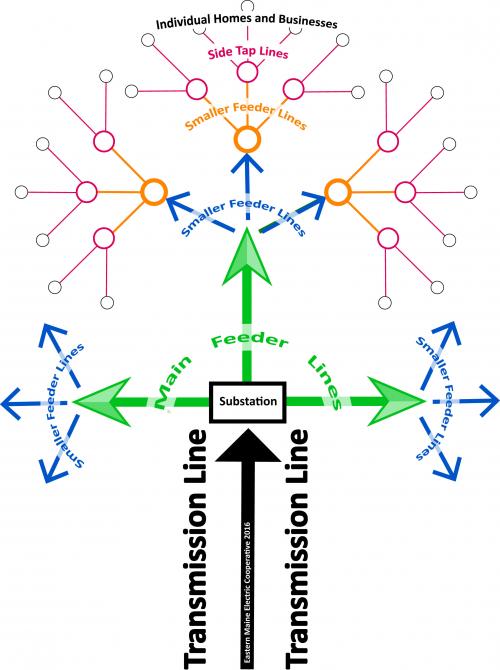Co‑op’s (EMEC’s) linemen are efficient and dedicated, but many people don’t realize there are only fourteen of them serving a 3,000-square-mile delivery territory. That makes work challenging, even during mild weather. When storms sweep through the area, though, the linemen can’t be everywhere at once. How, then, does the Co-op set priorities for restoring power during widespread outages?
The goal, of course, is to restore power to as many people as possible as soon as safely possible. That means the equipment repairs that will restore power to the largest number of members are made first.
This approach may sound simple and logical, but it means that sometimes a line crew must drive past a road without power on the way to take care of a main feeder serving hundreds of homes and businesses. A person on that road may see the truck go by without knowing why the crew didn’t stop.
Another critical factor in setting priorities is the design of the electric system itself. Rural electric grids are built radially from the substations, with feeder lines extending outward, the way a tree’s branches reach outward from its trunk. (Diagram to the right)
Main feeder lines serve large groups of people in a reasonably large area, like whole towns or people living along major traffic arteries (Routes 1,9, and 11, for instance).
The main feeders then branch out into smaller and smaller feeders as they extend further and further away from the substations.
Finally, “side tap” lines often extend out from feeder line circuits, to serve one or two homes that are off by themselves at a distance from the nearest road or cluster of homes.
This radial design often dictates the order in which repairs must be made. During widespread storms, crews must first repair the damage that is furthest “upstream” toward the power supply.
If the transmission line serving a substation is offline, for instance, everyone served by that substation will be without power. No amount of work on a feeder line will restore power to anyone until the transmission line is back on.
EMEC’s linemen can tackle a lot of damage on their own, but there are times when additional help is called in. The Cooperative has mutual aid agreements with other New England consumer-owned utilities. For example, mutual aid crews were called upon to help with repairs from the Christmas Ice Storm of 2013, and the remnants of Hurricane Arthur in July 2014. Line contractor crews may also be called in as needed.
Most of the time, Eastern Maine Electric’s linemen are able to restore power before help could arrive in time to make a difference. Their familiarity with the local area, with each other, and with the Eastern Maine Electric grid make them able to respond very efficiently. They are also highly motivated by the knowledge that it is their neighbors, friends, and family who are waiting for them to restore power.


